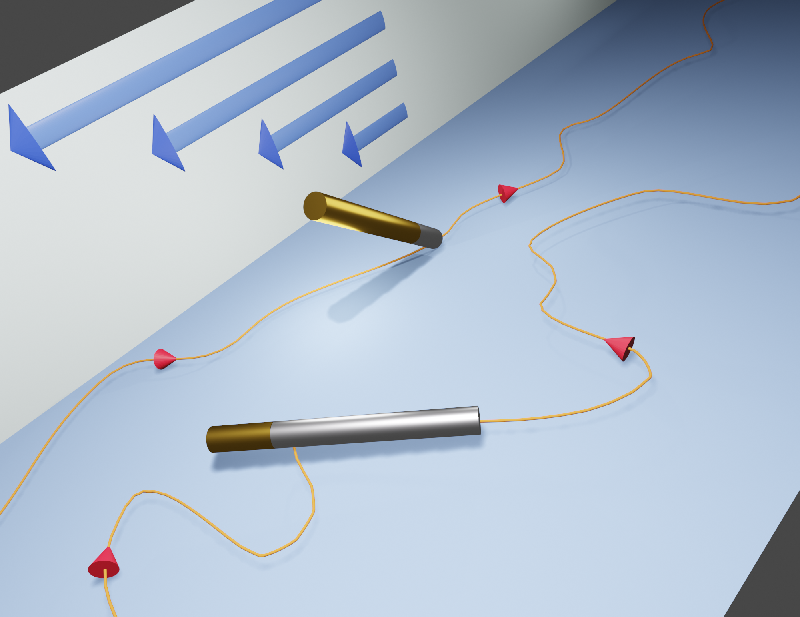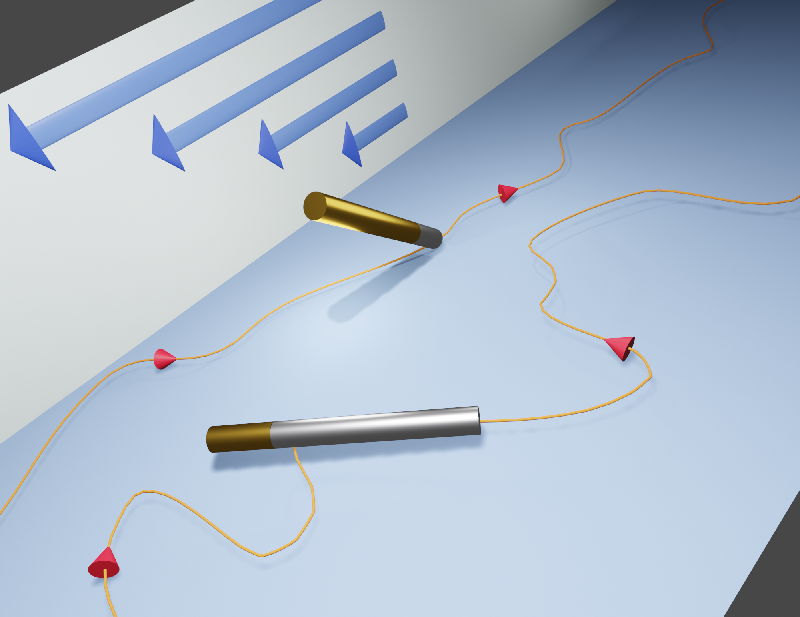Asymmetry Helps Tiny Rods Swim Upstream
A tiny metal rod made of gold and platinum segments can propel itself through a hydrogen peroxide solution. Now researchers have found that the relative lengths of the two portions influence the type of propulsion—whether the rod is a “pusher” or a “puller.” Adjusting the propulsion type affects the rod’s ability to orient itself and swim against the fluid’s flow direction, the team found. This ability plays a critical role in the behavior of many microorganisms, such as sperm cells, and is expected to be a desirable trait in artificial microswimmers that are being developed for purposes such as the transport of minuscule cargoes.
Researchers would like to design microrobots to carry out tasks such as drug delivery inside the human body or environmental cleanup through neutralization of pollutants. But experts are only beginning to figure out how to create and control practical devices. Experiments with rods that can “swim” like bacteria allow researchers to develop methods for microrobot control and to learn about the behaviors of microorganisms.
When immersed in a hydrogen peroxide solution, a rod made of gold and platinum segments reacts chemically and sends protons from the platinum end to the gold end. The protons drag fluid molecules with them, which propels the swimmer in the opposite direction through the fluid. In recent years, multiple research teams have confirmed experimentally that such “nanomotors” naturally swim against the fluid’s flow direction, a process called rheotaxis. The rods swim upstream in both strong and weak flows, and under some conditions they do so in close-packed groups [1, 2].
Whether swimmers are artificial or biological, they can be categorized by how they propel themselves. Propulsion comes from the rear for pushers, from the front for pullers, and from the middle for other propulsion types. Since gold-platinum nanomotors were invented 15 years ago [3], studies have focused solely on rods sporting equal-length segments of gold and platinum, which propel from their middle.
To investigate how a swimmer’s propulsion type might affect its rheotactic behavior, a team led by Michael Shelley and Jun Zhang of New York University has now fabricated and studied three types of 2-micrometer-long gold-platinum nanomotors. They included the familiar “symmetric” variety and two new types: “long-gold,” with gold segments 3 times longer than their platinum segments, and “long-platinum,” with the reverse structure. When placed in a hydrogen peroxide solution, the long-gold rods, with their gold-platinum interfaces up front, were pullers, while the long-platinum rods, with their interfaces closer to the rear, were pushers.
To assess the relative rheotactic capabilities among the three types, the team observed swimmers moving in a 300-micrometer-wide, 50-micrometer-tall microfluidic channel through which a hydrogen peroxide solution flowed. In experiments and simulations, the long-gold pullers oriented the quickest and most consistently into the flow, and the long-platinum pushers were the slowest and least consistent.
The team explained these results with a combination of simulations and a simple theory. While the rods generally settle near the bottom of the fluid channel, previous studies showed that if a rod swims with its head tilting down and tail up, it can more easily orient upstream than if it were horizontal. In comparison with horizontal rods, the uplifted tail is more strongly affected by the faster flow that is present farther from the “floor.” The simulations indicated that microscale fluid flows that straddle the gold-platinum junction cause a long-gold rod to tilt at a steeper angle than a long-platinum one, with a symmetric one somewhere in between. The steeper tilt leads to more effective rheotaxis. Turning the logic around, the team writes that one could observe an unknown microswimmer’s rheotaxis and use the new results to learn about the swimmer’s propulsion type and fluid flow details, which can be difficult to determine directly.
Researchers in the field are always looking for ways to customize microswimmers’ abilities, but there are few existing techniques to do so, says Zhang. “To our knowledge, this the first time [someone has] changed the junction position in order to change the rheotactic behavior.”
“It’s a very solid paper,” says soft-matter physicist Igor Aronson of Pennsylvania State University in University Park. “It’s the first systematic investigation of how the propulsion of the particle affects rheotaxis.”
This research is published in Physical Review Letters.
–Peter Weiss
Peter Weiss is a freelance science reporter and editor in Washington, D. C.
References
- L. Ren, D. Zhou, Z. Mao, P. Xu, T. Jun Huang, and T. E. Mallouk, “Rheotaxis of bimetallic micromotors driven by chemical–acoustic hybrid power,” ACS Nano 11, 10591 (2017).
- R. Baker, “Fight the flow: the role of shear in artificial rheotaxis for individual and collective motion,” Nanoscale 11, 10944 (2019).
- W. F. Paxton, K. C. Kistler, C. C. Olmeda, A. Sen, S. K. St. Angelo, Y. Cao, T. E. Mallouk, P. E. Lammert, and V. H. Crespi, “Catalytic nanomotors: Autonomous movement of striped nanorods,” J. Am. Chem. Soc. 126, 13424 (2004).





